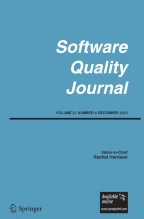Abstract
This paper addresses terminological consistency issues of three software testing glossaries used in academia and industry. The evaluation focus mainly deals with a sub-characteristic of information quality such as consistency, which includes syntactic and semantic consistency. To systematically conduct this study, we have established a set of activities or steps. These include defining the evaluation goal and scope, selecting the glossaries, conceiving the terminological categories, classifying the glossary terms into categories, calculating syntactic and semantic similarities, analyzing consistency, and making recommendations. For instance, for the testing domain, eight terminological categories were conceived, in which, for each selected glossary, a corresponding term is included in a category, considering the semantics intended by the authors of these standard documents. To count the occurrence frequency of a term in the glossaries, a tool was built that also takes into account the matching of synonyms. Then, a comparative analysis of syntactic and semantic consistency was carried out for all the terms ending in the word “testing,” which enables us to give recommendations. This exploratory study identifies some inconsistencies that might deserve further attention and efforts to promote agreement and harmonization among the authors/editors of these glossaries in order to provide their readers with the most consistent and easiest way to understand and learn software testing concepts.
Similar content being viewed by others
Data availability
All data generated or analyzed during this study are included in this published article and its supplementary information files linked at https://bit.ly/SQJ_Appendices.
References
Arnicane, V., Arnicans, G., & Borzovs, J. (2016). Building of concept system to improve systematic collection of terminology. Frontiers in Artificial Intelligence and Applications, 291, 313–326. https://doi.org/10.3233/978-1-61499-714-6-313
Becker, P., Papa, M. F., Tebes, G., & Olsina, L. (2022). Discussing the applicability of a process core ontology and aspects of its internal quality. Software Quality Journal, 30(4), 1003–1038. Springer. https://doi.org/10.1007/s11219-022-09592-3
Henderson-Sellers, B., Gonzalez-Perez, C., McBride, T., & Low, G. (2014). An ontology for ISO software engineering standards: 1) Creating the infrastructure. Computer Standards & Interfaces, 36(3), 563–576. https://doi.org/10.1016/j.csi.2013.11.001
ISO/IEC/IEEE 29119–1. (2013). Software and systems engineering – Software testing – Part 1: Concepts and definitions.
ISO/IEC/IEEE 29119–1. (2022). Software and systems engineering – Software testing – Part 1: General concepts.
ISTQB®, International Software Testing Qualifications Board. (2021). Standard glossary of terms used in software testing, version 3.5.
ISTQB®, International Software Testing Qualifications Board. (2022). Standard glossary of terms used in software testing, version 3.6.1. Automatically generated on September 26, 2022 from https://glossary.istqb.org/en/reports
Kuļešovs, I., Arnicane, V., Arnicans, G., & Borzovs, J. (2013). Inventory of testing ideas and structuring of testing terms. Baltic Journal of Modern Computing, 1(3–4), 210–227.
Olsina, L., Lew, P., Dieser, A., & Rivera, B. (2012). Updating quality models for evaluating new generation web applicationS. Journal of Web Engineering, Special issue: Quality in new generation Web applications, Abrahão S., Cachero C., Cappiello C., Matera M. (Eds.), Rinton Press, USA, 11:(3), pp. 209–246.
Olsina, L., Lew, P., & Tebes, G. (2022). Analyzing quality issues from software testing glossaries used in academia and industry. In: Vallecillo, A., Visser, J., Pérez-Castillo, R. (eds) Quality of Information and Communications Technology. QUATIC 2022. Communications in Computer and Information Science, Springer, 1621, 140–155, https://doi.org/10.1007/978-3-031-14179-9_10
Rout, T. P. (1999). Consistency and conflict in terminology in software engineering standards. 4th IEEE International Software Engineering Standards Symposium and Forum (ISESS'99), Best Software Practices for the Internet Age, 67–74.
Souza, E. F., Falbo, R. A., & Vijaykumar, N. L. (2013). Ontologies in software testing: A systematic literature review. CEUR Workshop Proceedings, 1041, 71–82.
Souza, E. F., Falbo, R. A., & Vijaykumar, N. L. (2017). ROoST: Reference ontology on software testing. Applied Ontology, 12(1), 59–90.
Tebes, G., Peppino, D., Becker, P., Matturro, G., Solari, M., & Olsina, L. (2020). Analyzing and documenting the systematic review results of software testing ontologies. Information and Software Technology, 123. https://doi.org/10.1016/j.infsof.2020.106298
Tebes, G., Olsina, L., Peppino, D., & Becker, P. (2021). Specifying and analyzing a software testing ontology at the top-domain ontological level. Journal of Computer Science & Technology (JCS&T), 21(2), 126–145. https://doi.org/10.24215/16666038.21.e12
TMMi Foundation. (2018). Test Maturity Model Integration (TMMi®) - Guidelines for test process improvement, release 1.2.
Funding
This line of research is supported partially by the Engineering School at Universidad Nacional de La Pampa, Argentina, in project 09-F079.
Author information
Authors and Affiliations
Contributions
Luis Olsina contributed to the updated exploratory study conception and design. Data collection and analysis were performed by Pablo Becker and Luis Olsina. The first draft of the manuscript was written by Luis Olsina and all authors commented on previous versions of the manuscript. All authors read and approved the final manuscript.
Corresponding author
Ethics declarations
Conflict of interest
The authors declare no competing interests.
Additional information
Publisher's Note
Springer Nature remains neutral with regard to jurisdictional claims in published maps and institutional affiliations.
Rights and permissions
Springer Nature or its licensor (e.g. a society or other partner) holds exclusive rights to this article under a publishing agreement with the author(s) or other rightsholder(s); author self-archiving of the accepted manuscript version of this article is solely governed by the terms of such publishing agreement and applicable law.
About this article
Cite this article
Olsina, L., Lew, P. & Becker, P. Comparative analysis of the syntactic and semantic consistency of terms in software testing glossaries. Software Qual J 32, 27–52 (2024). https://doi.org/10.1007/s11219-023-09638-0
Accepted:
Published:
Issue Date:
DOI: https://doi.org/10.1007/s11219-023-09638-0
